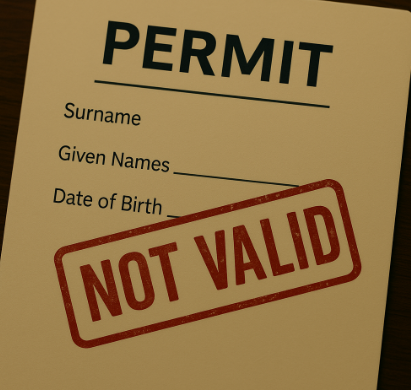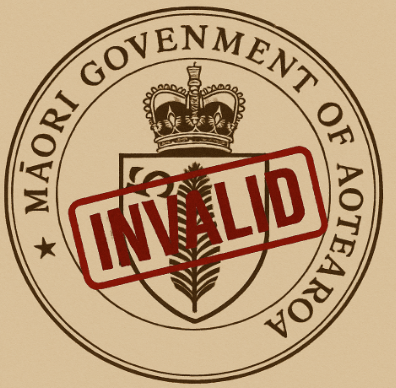Fabricated Sovereignty and Immigration Fraud: The Case of John Hikuwai
This profile outlines the strategic use of fabricated sovereignty by John Hikuwai in facilitating a large-scale immigration fraud operation. At the center of the case is the self-proclaimed “Maori Government of Aotearoa,” a non-recognized authority that issued illegitimate documents that were then sold to Thai migrants seeking asylum in New Zealand.
The Immigration Scheme and Fabricated Statehood
John Hikuwai appears to have emerged during the 1990s when he came under investigation by the Ministry of Fisheries for violating quota regulations. Claiming exemption from government regulations under Māori customary fishing rights, Hikuwai operated the James O’Brien vessel and defied multiple regulatory seizures. He made headlines in 1998 after threatening to forcibly claim his impounded boat and by 1999, he was fined $7,300 for breaching fishing limits. Identifying with the "Confederation of Chiefs of the United Tribes of Aotearoa," Hikuwai began presenting himself as a representative of an alternative government, one with no official or tribal mandate..
Between 2001 and 2007, Hikuwai became entangled with Thai businessman Nuttapat Tamaraksaroj (aka Dr Lee, Chris Siam) and two Thai exiled monks in an elaborate immigration fraud scheme. Tamaraksaroj established a dubious Buddhist temple in Auckland, while Hikuwai offered “Government of Aotearoa” work permits to asylum seekers for a fee. These documents, issued under the banner of a fictional “Maori Government of Aotearoa Transport Office,” were completely fraudulent. Claiming to assist Thai nationals fleeing religious persecution, the duo offered pathways to residency through [false] adoption into Māori whānau and affiliation with a supposed independent state the “Maori Government of Aotearoa.” The scam extended beyond paperwork. Migrants were told that adoption into a Māori whānau, at a cost of $3,000, would improve their immigration prospects. Some refugees reported when they arrived at Hikuwai’s location in Wainui Bay, they found thirty other Thai people undergoing the same fabricated process.
Migrants were also charged $500 for work permits, all of which were legally baseless. In relation to just two of these bogus permits sold in 2002, Hikuwai falsely declared that the refugee claimants understood their applications, a legal fallacy that further compounded the fraud. His assertions to immigration investigators that the work permits were valid was later described by Judge Moore as “100 per cent ineffectual and meanginless”…..”were not worth the paper they were written on”.
At least 285 Thai nationals participated, believing the documents would support successful refugee claims. These false claims triggered a cascade of legal scrutiny. According to the New Zealand Refugee Status Appeals Authority (NZRSAA), the scam directly resulted approximately 50 refugee appeal hearings in the early 2000’s, many of which are now publicly documented.
Snapshot of appeals:
Refugee Appeal No. 74432 [2003] NZRSAA 37 (30 January 2003)
Refugee Appeal No. 74200 [2003] NZRSAA 143 (3 April 2003)
Refugee Appeal No. 74282 [2003] NZRSAA 222 (11 June 2003)
Refugee Appeal No. 74427 [2003] NZRSAA 478 (15 December 2003)
Refugee Appeal No. 74489 [2003] NZRSAA 40, included a strong rebuke:
“Neither Mr Hikuwai nor the appellant has refuted these allegations. Indeed, the Authority reiterates that unfortunately it has had a large number of other claims lodged by Mr Hikuwai which have been equally lacking in merit and apparently abusive. Although it is a statement of the obvious, dealing with such applications is a shameful waste of the limited resources of the Refugee Status Branch and the Authority.”
This statement provides direct institutional recognition of the scale of abuse. It highlights the burden placed on already constrained refugee processing systems and underlines how fraudulent appeals can undermine the credibility of legitimate asylum seekers. In each of these cases, applicants relied on narratives and documents shaped by Hikuwai and Tamaraksaroj. The Refugee Status Appeals Authority repeatedly concluded that these claims were not only unfounded but appeared to be part of a coordinated deception.
Tamaraksaroji was the main architect of the scheme. Thai officials estimated migrants paid him up to 100,000 baht ( Approx. NZD $5400) through a trust set up as an “asylum-seeker processing company”. Overall Thai officials estimated the total amount extracted could have reached NZD $1 million. When the scheme started to fall apart Tamaraksaroji declared he would redirect efforts to Canada instead. The Canadian immigration officials effectively blocked the move. Despite mounting media exposure and investigations he publicly claimed that his actions were lawful and blamed Hikuwai for the applications failing. However, he had been linked to other immigration schemes around the world. Hikuwai said he became involved because Tamaraksaroji owed him $50,000 from a failed fishing venture in Thailand. He said he went to Thailand to crew a fishing boat that was meant to go to South Korea, but the deal fell through, resulting in his return to New Zealand. Immigration (as of 2001) believed he was linked to one case involving 200 individuals alone.
In 2007, Hikuwai was convicted in the Auckland District Court on three immigration fraud charges and sentenced to 21 months in prison although granted the opportunity to apply for home detention. The court found that he had misrepresented the content of refugee applications and issued work permits with no legal authority. Judge Lindsay Moore stated unequivocally:
“There can be no question but that the basis for each claim did not come from the respective applicants but was a dishonest and indeed abusive exercise dreamt up by Mr Hikuwai and his associates who used it over and over again.”
In a separate incident in 2003, Hikuwai was charged with arson after setting fire to the home of a former partner. Though he denied the allegations, he was found guilty. Judge Mary-Elizabeth Sharpe remanded him for sentencing. The immigration fraud orchestrated by John Hikuwai under the guise of the “Maori Government of Aotearoa” represents the intersection of (mis)appropriation of indigenous culture, legal manipulation, and transnational exploitation. With over 50 asylum hearings, significant media coverage, and multiple criminal convictions, the case illustrates how pseudo-sovereign rhetoric can be appropriated for deeply harmful purposes. This harm also extends to the sovereign individual themselves in most cases.
James Gardiner. “Fisherman threatens to grab back boat”. NZ Herald, 27 Jan 1998
Paul Yandall. “Migrant Scam Boss Targets Canada”. NZ Herald, 19 Nov 2001
NZ Herald. “Hikuwai on trial for arson”. 12 Nov 2003.
David Eames. “Maori Radical set fire to girlfriends house”, NZ Herald, 27 Jan 2006.
Eugene Bingham & John Andrews. “Monks in Migrant Scam”, NZ Herald, 17 Nov 2001.
NZ Herald. “ Man jailed for selling worthless work permits”, NZ Herald, 27 June 2007.
Nicola Boyes. “Thai tells of Maori Ceremony at Centre of Alleged immigration scam”.
TE KARERE – HIKUWAI HOWELL, Ngā Taonga Sound & Vision, 1999 https://www.ngataonga.org.nz/search-use-collection/search/TZP214981/
Numerous Refugee Appeals are on file related to Hikuwai can be found in legal archives. (From New Zealand Refugee Status Appeals Authority).


